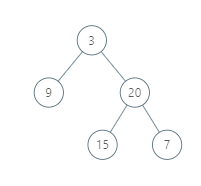Leetcode - vertical-order-traversal-of-a-binary-tree
https://leetcode.com/problems/vertical-order-traversal-of-a-binary-tree/
Given a binary tree, return the vertical order traversal of its nodes values.
For each node at position (X, Y), its left and right children respectively will be at positions (X-1, Y-1) and (X+1, Y-1).
Running a vertical line from X = -infinity to X = +infinity, whenever the vertical line touches some nodes, we report the values of the nodes in order from top to bottom (decreasing Y coordinates).
If two nodes have the same position, then the value of the node that is reported first is the value that is smaller.
Return an list of non-empty reports in order of X coordinate. Every report will have a list of values of nodes.
Example 1:
Input: [3,9,20,null,null,15,7] Output: [[9],[3,15],[20],[7]] Explanation: Without loss of generality, we can assume the root node is at position (0, 0): Then, the node with value 9 occurs at position (-1, -1); The nodes with values 3 and 15 occur at positions (0, 0) and (0, -2); The node with value 20 occurs at position (1, -1); The node with value 7 occurs at position (2, -2).
Use bfs to traverse the tree, store a hash: hd -> tree value
1 2 3 4 5 6 7 8 9 10 11 12 13 14 15 16 17 18 19 20 21 22 23 24 25 26 27 28 29 30 31 32 33 34 35 36 37 38 39 40 41 42 43 44 45 46 47 48 49 50 51 52 53 54 55 56 57 58 59 60 61 62 63 64 65 66 67 68 69 70 71 72 73 74 75 76 77 78 79 80 81 82 | /** * Definition for a binary tree node. * type TreeNode struct { * Val int * Left *TreeNode * Right *TreeNode * } */type TreeWithDistance struct { node *TreeNode hd int level int}func verticalTraversal(root *TreeNode) [][]int { if root == nil { return [][]int{} } queue := []*TreeWithDistance{{node: root, hd: 0, level: 0}} hash := map[int][]*TreeWithDistance{} min := math.MaxInt32 max := math.MinInt32 level := 0 for len(queue) != 0 { size := len(queue) for i := 0; i < size; i++ { tmp := queue[i] hd := tmp.hd node := tmp.node hash[hd] = append(hash[hd], tmp) if node.Left != nil { queue = append(queue, &TreeWithDistance{ node: node.Left, hd: hd - 1, level: level, }) } if node.Right != nil { queue = append(queue, &TreeWithDistance{ node: node.Right, hd: hd + 1, level: level, }) } if min > hd { min = hd } if max < hd { max = hd } } queue = queue[size:] level++ } result := [][]int{} for i := min; i <= max; i++ { if val, ok := hash[i]; ok { sort.Slice(val, func(i, j int) bool { if val[i].hd < val[j].hd { return true } if val[i].hd > val[j].hd { return false } if val[i].level < val[j].level { return true } if val[i].level > val[j].level { return false } return val[i].node.Val < val[j].node.Val }) tmpResult := []int{} for _, n := range val { tmpResult = append(tmpResult, n.node.Val) } result = append(result, tmpResult) } } return result} |

3 年前
We have been waiting for a long period of time where we can get an amazing Instruction that can be followed for long time.
11 个月前
am overwhelmed by your post with such a nice topic. Usually I visit your blogs and get updated through the information you include but today’s blog would be the most appreciable. Well done!
9 个月前
sex story in hindi
9 个月前
join our service